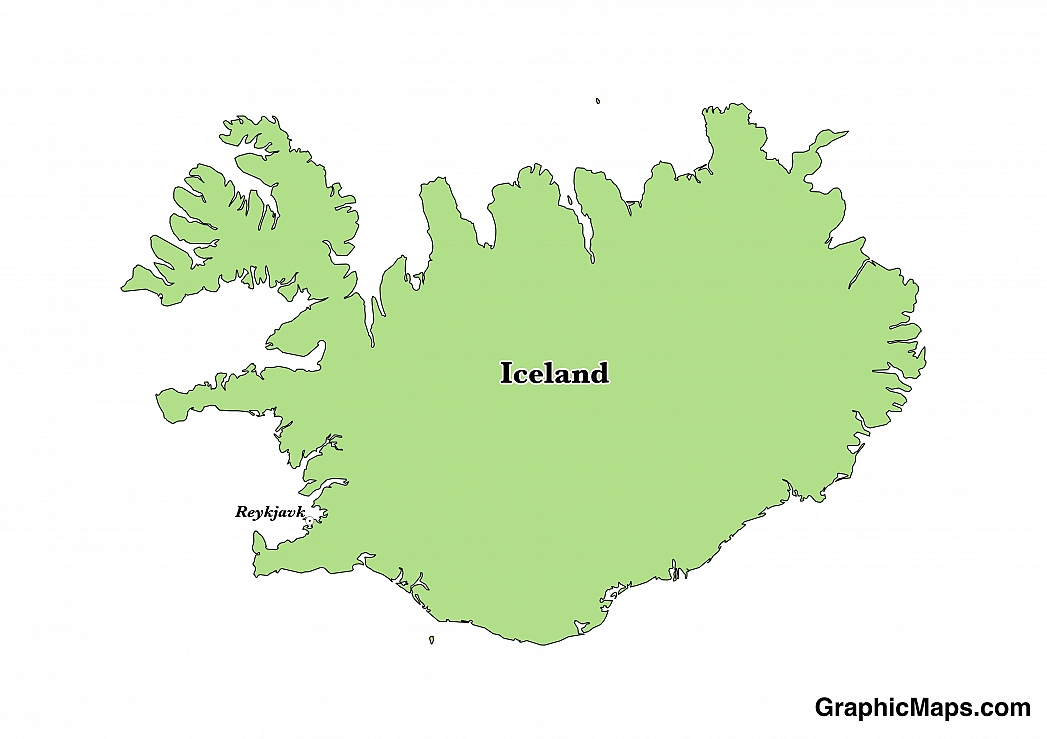Where is Iceland?
Located in Northern Europe, Iceland is an island nation. It has a 4,970.00 km coastline. Iceland, the United Kingdom, and Ireland dispute Denmark's claim that the Faroe Islands continental shelf extends beyond 200 nm.
Reykjavík is the capital city of Iceland. This city was founded as an urban economic center in the year 1786. It is located in southwestern Iceland on the southern coast of Faxa Bay. The city itself has a population of 123,300 people within its borders and almost double the number in the Capital Region. Reykjavík is popular among tourists to an extent where the population of tourists and temporary residents sometimes exceeds that of locals in the city. The climate of Reykjavík is described as subpolar oceanic. The hottest and sunniest month of the year is May.
Read more on Iceland's CapitalIceland is a European country covering 103,000.00 km2 of which 2.67% is water and 100,250.00 km2 is land. This makes it the 106th largest country in the world and slightly smaller than Pennsylvania; about the same size as Kentucky. Its geographic coordinates are 65 00 N, 18 00 W and Reykjavik is the capital city.
The country was named "land of ice" by an early explorer of the island.
Its ISO code is IS.
Geography
Iceland has a mean elevation of 557 m above sea level.
It has a temperate climate due to the moderation of the North Atlantic Current. Its terrain is mostly made up of plateaus with some mountain peaks and icefields.
Population
Iceland has a population of 335,878 making it the 177th largest in the world. Half of the country's population lives in Reykjavik.
Icelandic is the official language. The major ethnic group reported is a homogenous mixture of Norse and Celts. The majority of the population belongs to the Evangelical Lutheran Church of Iceland.
The official and most spoken language in Iceland is Icelandic. This language has an alphabet of 32 letters. Icelandic is widespread throughout the country with about 97% of the population claiming it as their mother tongue. Out of Iceland’s population of 332,529 people, 320,000 of these speak Icelandic. Icelanders prefer maintaining their language by creating new words rather than borrowing words from other languages. Over the years, northern trade routes have introduced minority languages in Iceland which include Latvian, Thai, Filipino, Portuguese, Danish, German, English, Lithuanian and Polish.
Read more on Iceland's LanguagesThe dialing code for the country is 354.
Government
Iceland is an independent country. It became a sovereign state under the Danish Crown in 1918. Its constitution was last ratified in 1944.
The government of Iceland is referred to as the Republic of Iceland. The type of government can be described as a constitutional Republic. Iceland adopted its constitution in 1944 which put in place a parliamentary democracy. The executive is made up of a ceremonial president who is elected through a plurality vote and a prime minister who is appointed by the president. Power lies with the Althingi (Parliament). There is also a judicial system that offers the final court of appeal for the land and a legislative body which is in charge of the legislature.
Read more on Iceland's GovernmentEconomy
Factoring in Purchasing Power Parity, Iceland's GDP is $16,150,000,000.00 (USD) with $48,100.00 (USD) per capita. This makes it the 151st largest economy and its citizens the 30th richest in the world. The currency of Iceland is the Krona (ISK).
Its major export partners are the Netherlands, the United Kingdom, and Spain. Its main exports are fish and fish products. Its major import partners are Norway, Germany, the United States. Its major imports include machinery and equipment, petroleum products, foodstuffs, and textiles.
Flag
The flag of Iceland is officially referred to as íslenski fáninn in Icelandic. Iceland became its own republic on June 17th of 1944. This date also marked the official adoption of the country‘s flag through a law that was passed on the same day. The official flag is sky blue with a snow-white cross inside the blue; inside the white cross is a fiery red cross. The tips of the cross touch the edges of the flag. The width of the two flags is 2/9 while that of the red cross is 1/9 the width of the whole flag. The blue areas of the flag are rectangles, the smaller ones being half the length of the outer rectangles. The comparison in length between the width and length is 18:25.
Read more on Iceland's FlagThis page was last modified on January 17th, 2018
More on Graphicmaps

Published on 2019-11-06
What is a Trade Embargo?

Published on 2019-11-04
Which Two Countries Used to Have the Same Flag?

Published on 2019-09-16
What Is the Only Two-Sided State Flag?

Published on 2019-09-16
Which Country Flag Looks Like the Texas Flag?

Published on 2019-08-29
Flags That Resemble the US Flag

Published on 2019-08-20
